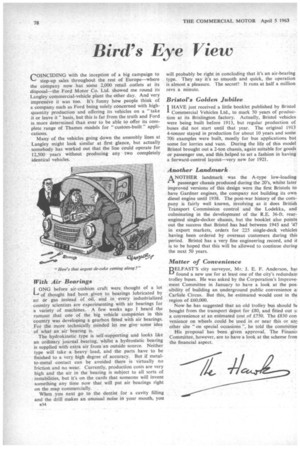Bird's Eye View
Page 80

If you've noticed an error in this article please click here to report it so we can fix it.
COINCIDING with the inception of a big campaign to step-up sales throughout the rest of Europe—where the company now has some 2,000 retail outlets at its disposal—the Ford Motor Co. Ltd. showed me round its Langley commercial-vehicle plant the other day. And very impressive it was too. It's funny how people think of a company such as Ford being solely concerned with highquantity production and offering its vehicles on a "take it or leave it" basis, but this is far from the truth and Ford is more determined than ever to be able to offer its complete range of Thames models for " custom-built " applications. Many of the vehicles going down the assembly lines at Langley might look similar at first glance, but actually somebody has worked out that the line could operate for 12,500 years without producing any two completely identical vehicles.
With Air Bearings
ONG before air-cushion craft were thought of a lot 1-1" of thought had been given to bearings lubricated by air or gas instead of oil, and in every, industrialized country scientists are experimenting with air bearings for a variety of machines. A few weeks ago I heard the rumour that one of the big vehicle companies in this country was developing a gearbox fitted with air bearings. For the more technically minded let me give some idea of what an air bearing is.
The hydrokinetic type is self-supporting and looks like an ordinary journal bearing, whilst a hydrostatic bearing is supplied with extra air from an outside source. Neither type will take a heavy load, and the parts have to be finished to a very high degree of accuracy. But if metalto-metal contact can be avoided there is virtually no friction and no wear. Currently, production costs are very high and the air in the bearing is subject to all sorts of instabilities, but it's on the cards that someone will invent something any time now that will put air bearings right on the map commercially. When you next go to the dentist for a cavity filling and the drill makes an unusual noise in your mouth, you B34 will probably be right in concluding that it's an air-bearing type. They say it's so smooth and quick, the operation is almost a pleasure. The secret? It runs at half a million revs a minute.
Bristol's Golden Jubilee
I HAVE just received a little booklet published by Bristol Commercial Vehicles Ltd., to mark 50 years of production at its Brislington factory. Actually, Bristol vehicles were being built before 1913, but regular production of buses did not start until that year. The original 1913 4-tonner stayed in production for about 10 years and some 700 examples were built, mostly for bus applications but some for lorries and vans. During the life of this model Bristol brought out a 2-ton chassis, again suitable for goods or passenger use, and this helped to set a fashion in having a forward-control layout—very new for 1921.
Another Landmark
NOTHER landmark was the A-type low-loading passenger chassis produced during the 20's, whilst later improved versions of this design were the first Bristols to have Gardner engines, the company not building its own diesel engine until 1938. The post-war history of the company is fairly well known, involving as it does British Transport Commission control and the Lodekka, and culminating in the development of the R.E. 36-ft. rearengined single-decker chassis, but the booklet also points out the success that Bristol has had between 1945 and '47 in export markets, orders for 225 single-deck vehicles having been ordered by overseas customers during this period. Bristol has a very fine engineering record, and it is to be hoped that this will be allowed to continue during the next 50 years.
Matter of Convenience
BELFAST'S city surveyor, Mr. J. E. F. Anderson, ha,
found a new use for at least one of the city's redundant trolley buses. He was asked by the Corporation's Improvement Committee in January to have a look at the possibility of building an underground public convenience al Carlisle Circus. But this, he estimated would cost in thi region of £60,000.
Now he has suggested that an old trolley bus should bi bought from the transport depot for £80, and fitted out at a convenience at an estimated cost of £750. The £830 con venience on wheels could be used in or near this or an! other site "on special occasions ", he told the committee
His propcisal has been given approval. The Finanet Committee, however, are to have 'a look at the scheme fron the financial aspect.








































































































































